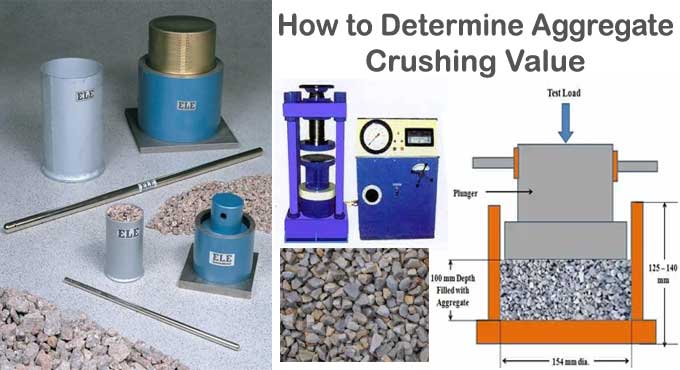
Tests to Determine the Crushing Strength of Aggregates in Construction

The mechanical strength of a road-stone is one of the major requirements. It is used to determine aggregates' ability to withstand stress caused by moving vehicles, namely crushing by moving vehicles.
As well as providing sufficient resistance to crushing under the roller, the aggregates should also resist crushing under the rigid tires of heavily loaded animal-drawn vehicles. A higher aggregate crushing value indicates more resistance to crushing under a compressive load. The ideal pavement aggregate will be one with a low aggregate crushing value.
Objectives
1. The purpose of crushing aggregate is to determine its value as an aggregate for roads.
2. Assessing aggregates' suitability for pavement purposes.
Equipment
It is a steel cylindrical of internal diameter 15.2 cm with open ends. The piston has a diameter of 15 cm and mounts on a square base plate. The internal diameter of the cylindrical measure is 11.5 cm, and its height is 18 cm. Tamping rod made of steel.
The diameter is 1.6 cm & length is 45 to 60 cm, Precision correction of up to 1 gm for 3 kg balance. A compression tester with a loading rate of 4 tons per minute can apply 40 tones of pressure.
Precautions
1. In order to properly place the plunger, it should rest directly over the aggregate. It should be taken care that the cylinder walls do not come into contact with the container in order to ensure that the entire load is transferred onto the aggregate.
2. It is vital that fines are not lost during sieving and weighting the aggregates through a 2.36 mm sieve. Summation of the weights of the fractions retained after sieving and those passing it should be no more than 1 gm from the original weight.
3. It is recommended to drop the tamping rod gently rather than hammer it. It is important to keep the tamping rod from striking the walls of the mould when tamping the aggregates.
Testing Procedure
1. Aggregates are selected that have been surface-dried, passed 12.5 mm sieves, and retained on 10 mm sieves before testing.
2. Each layer of the cylindrical measure is tamped 25 times with the rounded end of the tamping rod by the test sample of the aggregate.
3. To level off the aggregate at the top of the cylindrical measure, use the tamping rod as a straight edge after the third layer has been tamped. A test sample is weighed next. The WI GM will take care of that.
4. A third of the sample from the cylindrical measure is transferred to the test cylinder and tamped 25 times by the round end of the tamping rod. Then the cylinder of the test apparatus is placed on the base plate.
5. Then tamp the three layers of aggregate each 25 times, each layer being approximately equal in depth.
6. A compression testing machine is then placed on the cylinder with the sample and plunger attached.
7. During the next 15 seconds, a constant 4 tones per minute force is applied through the plunger until the total load is 40 tones, then the load is released.
8. Material which passes the 2.36mm IS. The sieve is collected and weighed after aggregates are removed from the cylinder, including the crushed position. Let's call this W2GM.
9. Repeat the above steps with another sample of the same aggregate. Averaging the results from two tests of the same specimen is done.
10. The bulk weight of the dry sample you took was WI gm and weight of the crushed materials that passed the 2.36mm IS screen was W2 gm. As a result, aggregate crushing value was the weight of fines passing the IS sieve divided by the total sample weight.
Wrapping It Up
The compressive strength of the parent rock is not always reflective of the strength of the aggregate. It is for this reason that bulk aggregate is used for assessing aggregate strength. Aggregate crushing strength testing is a method of testing.
To learn more, watch the following video tutorial.
Video Source: Er. Sathavara Dinesh
It is extremely important to perform a test on aggregate crushing strength. A rectangular specimen of 25mm in diameter and 25mm in height can be used to determine an aggregate parent rock's strength. Compressive stress applies to this cylinder. There are a variety of parent rocks with compressive strengths ranging from 45MPa to 545Mpa.An aggregate sample's crushing value is determined by applying a gradually increasing compressive load to it. Test participants are typically required to pass 12.5 mm of aggregate and retain it on a 10mm sieve. Within a compression test machine, a load of 40 tons applies to the sample within a cylindrical mold.
Read More
Concrete Tensile Strength Test in Construction
The 10 Types of Concrete Used in Construction


